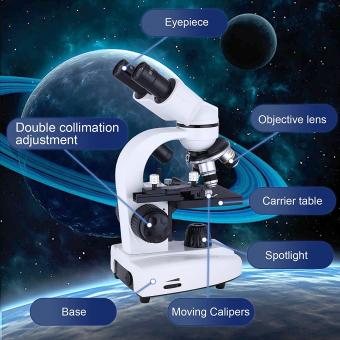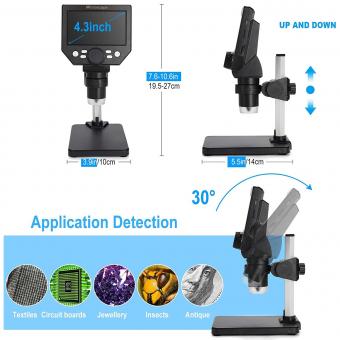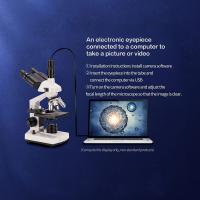Can We See Dna Under Microscope ?
No, DNA cannot be seen directly under a light microscope. It is too small to be resolved by the magnification power of a light microscope, which typically ranges from 100x to 1000x. DNA molecules are on the nanometer scale, while the resolution limit of a light microscope is around 200-300 nanometers. To visualize DNA, techniques such as fluorescence microscopy or electron microscopy are used, which provide higher magnification and resolution capabilities.
1、 DNA Structure and Composition
Yes, we can see DNA under a microscope. However, it is important to note that DNA is a very small molecule, and traditional light microscopes are not powerful enough to directly visualize individual DNA strands.
In the past, scientists used staining techniques to make DNA visible under a light microscope. These techniques involved treating the DNA with dyes that would bind to the molecule and make it visible. However, this process often resulted in the distortion or destruction of the DNA structure, limiting the accuracy of the observations.
With advancements in technology, electron microscopes have been developed that can provide higher resolution images of DNA. Electron microscopes use a beam of electrons instead of light to visualize objects, allowing for much greater magnification and resolution. By using electron microscopy, scientists have been able to observe the double helix structure of DNA and study its composition in more detail.
Furthermore, recent developments in super-resolution microscopy techniques have allowed scientists to visualize DNA at an even higher resolution. These techniques, such as stimulated emission depletion (STED) microscopy and single-molecule localization microscopy (SMLM), can overcome the diffraction limit of light and provide detailed images of DNA at the nanoscale level.
It is important to note that while we can see DNA under a microscope, the visualization of DNA alone does not provide information about its function or the genetic information it carries. To understand the role of DNA in biological processes, scientists often use techniques such as DNA sequencing and genetic engineering to study the specific sequences and functions of DNA molecules.

2、 DNA Replication and Repair
Yes, we can see DNA under a microscope. However, it is important to note that DNA itself is not visible to the naked eye or even under a light microscope. DNA molecules are extremely small, with a diameter of about 2 nanometers. This is much smaller than the resolution limit of a light microscope, which is around 200 nanometers. Therefore, to visualize DNA, scientists use specialized techniques and instruments such as electron microscopes.
Electron microscopes use a beam of electrons instead of light to magnify the sample. This allows for much higher resolution imaging, enabling scientists to see individual DNA molecules. With the help of electron microscopy, researchers have been able to observe the structure of DNA, including its double helix shape.
In recent years, advancements in microscopy techniques have allowed for even more detailed visualization of DNA. For example, super-resolution microscopy techniques such as stimulated emission depletion (STED) microscopy and single-molecule localization microscopy (SMLM) have been developed. These techniques can achieve resolutions beyond the diffraction limit of light, allowing for the visualization of DNA at the nanoscale.
Furthermore, fluorescent labeling techniques can be used to specifically label DNA molecules with fluorescent dyes, making them visible under a fluorescence microscope. This enables researchers to study various aspects of DNA, such as its localization within cells or its interactions with other molecules.
In summary, while DNA itself is not visible under a light microscope, specialized techniques such as electron microscopy and super-resolution microscopy, as well as fluorescent labeling, allow us to visualize and study DNA at the molecular level. These advancements have greatly contributed to our understanding of DNA replication and repair processes.

3、 DNA Packaging and Chromatin Structure
Yes, we can see DNA under a microscope, but it is important to note that DNA is not visible directly. DNA is a very small molecule, and its individual strands cannot be seen using a light microscope, which has a limited resolution. However, with the help of various techniques and staining methods, we can indirectly visualize DNA and study its packaging and chromatin structure.
One commonly used technique is fluorescence in situ hybridization (FISH), which involves labeling specific DNA sequences with fluorescent probes. These probes bind to complementary DNA sequences, allowing us to visualize specific regions of DNA under a fluorescence microscope. FISH has been instrumental in studying the organization and localization of DNA within the nucleus.
Another technique is electron microscopy (EM), which provides higher resolution than light microscopy. EM can be used to visualize the overall structure of chromatin fibers and the packaging of DNA within the nucleus. By using specialized sample preparation techniques, such as freeze-fracture or thin-sectioning, researchers can obtain detailed images of chromatin structure.
Recent advancements in super-resolution microscopy techniques, such as structured illumination microscopy (SIM) and stochastic optical reconstruction microscopy (STORM), have further improved our ability to visualize DNA at a higher resolution. These techniques allow researchers to study the organization of DNA and chromatin at the nanoscale level.
In conclusion, while DNA itself cannot be directly seen under a light microscope, various techniques and advancements in microscopy have enabled us to visualize and study DNA packaging and chromatin structure. These techniques have provided valuable insights into the organization and function of DNA within the nucleus.

4、 DNA Transcription and RNA Processing
Yes, we can see DNA under a microscope, but it is important to note that DNA itself is not visible under a light microscope due to its small size. DNA molecules are typically only a few nanometers in diameter, which is much smaller than the resolution limit of a light microscope. However, there are techniques that allow us to indirectly visualize DNA using fluorescence microscopy.
Fluorescence in situ hybridization (FISH) is a commonly used technique to visualize specific DNA sequences. In FISH, DNA probes labeled with fluorescent dyes are used to bind to complementary DNA sequences in the sample. The fluorescent signal emitted by the probes can then be visualized under a fluorescence microscope, allowing us to see the location and distribution of specific DNA sequences within cells or tissues.
Another technique called electron microscopy (EM) can provide higher resolution images of DNA. EM uses a beam of electrons instead of light to visualize samples. By preparing DNA samples for EM, such as embedding them in a resin and staining them with heavy metals, it is possible to observe the fine structure of DNA molecules at a much higher resolution.
It is worth mentioning that recent advancements in super-resolution microscopy techniques have allowed scientists to visualize DNA at an even higher resolution. These techniques, such as stimulated emission depletion (STED) microscopy and single-molecule localization microscopy (SMLM), can overcome the diffraction limit of light and provide detailed images of DNA structures.
In summary, while DNA itself is not directly visible under a light microscope, various techniques such as FISH, electron microscopy, and super-resolution microscopy enable us to visualize DNA and study its structure and organization within cells.








































